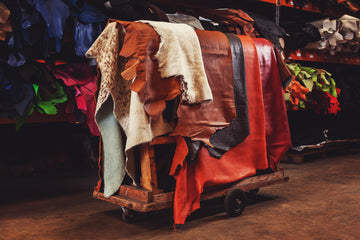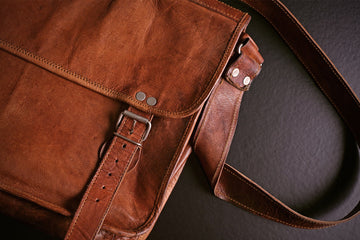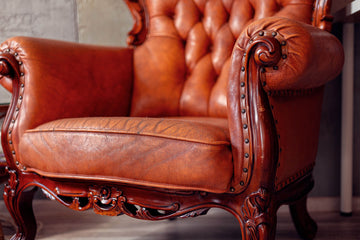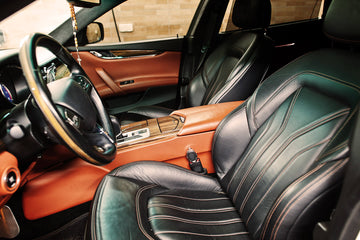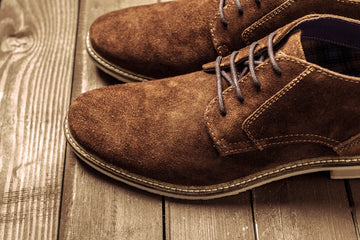The difference between a satchel that becomes a cherished companion for decades and one that deteriorates within months often comes down to a single crucial decision: choosing the right type of leather.
While the leather industry offers countless options, from genuine leather to exotic leathers, selecting the ideal material for your satchel project requires understanding the complex relationship between leather grades, animal hides, tanning processes, and intended use.
Whether you're crafting classic leather satchels for professional use or designing rugged bags for outdoor adventures, the leather you choose will determine everything from durability and appearance to comfort and cost.
This comprehensive guide will walk you through the essential factors that distinguish a quality leather bag from a mediocre one, helping you make informed decisions that result in the highest-quality satchel for your specific needs. Selecting the right leather is the foundation for crafting the ideal bag—one that perfectly balances practicality, style, and suitability for any occasion.
Introduction to Leather Satchels
Leather satchels have long been celebrated as both a practical accessory and a timeless fashion statement. Their enduring popularity stems from their ability to effortlessly blend style and function, making them a staple in wardrobes around the world. Whether you're heading to the office, travelling, or simply looking for a reliable everyday bag, leather satchels offer unmatched versatility and sophistication.
When selecting a leather satchel, understanding the different types of leather is key to finding the perfect match for your needs. Genuine leather, grain leather, and top grain leather are among the most sought-after materials for leather bags, each bringing its own set of qualities to the table. Full-grain leather, renowned for its natural markings and ability to develop a rich patina, is often considered the highest quality option, offering a luxurious feel and exceptional durability. Cowhide leather bags, in particular, are prized for their strength and resilience, making them an excellent choice for those seeking a bag that can withstand daily wear and tear.
Satchel Functionality and Purpose
The intended functionality and purpose of your leather satchel are crucial factors in determining the best type of leather for your project. If you need a satchel that can handle the rigours of daily commuting or frequent travel, opting for a more durable leather such as bridle leather or cowhide leather is a smart choice. These types of leather are known for their robust grain structure and ability to withstand harsh conditions, ensuring your bag remains reliable and long-lasting.
On the other hand, if you're seeking a classic leather satchel for formal occasions or special events, you might prioritise aesthetic appeal and unique textures. In these cases, full-grain leather or even exotic leathers can provide a refined look and feel, elevating your accessory to a statement piece. The natural grain and quality of these leathers add a touch of luxury and sophistication, making them ideal for classic styles.
Ultimately, matching the type of leather to the satchel's intended use ensures you achieve the right balance of durability, style, and quality. Whether you need a rugged, everyday companion or a classic accessory for special occasions, understanding the purpose of your satchel will guide you toward the most suitable leather choice.
Best Leather Types for Satchel Making
When evaluating the best leather to use for satchels, five primary options consistently rise above the rest. Each offers distinct advantages depending on your intended purpose, budget, and desired aesthetic.
Full-grain vegetable-tanned cowhide stands as the gold standard for premium leather satchels. This type of leather retains the complete top layer of the animal hide, preserving all natural markings and the strongest fibre structure. Its natural appearance, with unique grain and markings, adds character and authenticity to each satchel. The vegetable tanning process, which takes 6-12 months, creates leather that develops a rich patina over time while maintaining exceptional durability. Leading manufacturers like The Cambridge Satchel Company exclusively use this material for their flagship products, emphasising its unmatched longevity and repair capabilities.
Top-grain cowhide offers an excellent balance of quality and affordability for professional satchels. While the surface undergoes light sanding to create a more uniform appearance, it maintains the structural integrity needed for daily use. This leather type provides consistent finishing options while remaining more accessible than full-grain alternatives.
Bridle leather represents the pinnacle of durability for heavy-duty applications. Originally developed for horse tack, this vegetable-tanned leather undergoes additional treatments with oils and waxes, creating a leather product that can withstand harsh conditions while maintaining flexibility. The exquisite texture and natural water resistance make it an excellent choice for work satchels and outdoor accessories.
Chrome-tanned leather delivers flexibility and faster production times, making it popular for contemporary satchel designs. The chemical tanning process, completed in 24-48 hours, creates softer, more pliable leather suitable for unstructured bags. This soft feel enhances comfort and ease of use, making chrome-tanned leather especially appealing for everyday accessories. While it lacks the patina development of vegetable-tanned options, chrome-tanned leather offers superior initial softness and a wider range of colour options.
Buffalo leather provides rugged strength for outdoor and work satchels. Its naturally thick hide and distinctive grain patterns create leather bags with exceptional structural integrity. The natural water resistance and ability to hide wear make buffalo an ideal choice for satchels intended for field work or challenging environments.
Split leather is another option produced by splitting the hide after removing the fur. It is valued for its balance of toughness and flexibility, making it suitable for certain satchel applications.
Understanding Leather Grades for Satchels
The hierarchy of leather quality directly impacts both the performance and longevity of your finished satchel. Understanding these grades enables you to select materials that match your quality expectations and budget constraints.
The leather industry classifies products into distinct grades based on which layer of the animal skin is used and how extensively it's processed. This grading system serves as a reliable indicator of durability, appearance, and price points, making it essential knowledge for anyone serious about creating quality leather accessories.
The grade you choose will significantly affect the overall durability of your satchel, as higher grades typically offer better resistance to wear and longer-lasting construction.
Full-Grain Leather: Premium Choice for Luxury Satchels
Full-grain leather represents the highest quality available, utilising the complete top layer of the hide without removing or altering the natural grain. This preservation of the outermost layer means every natural characteristic, including scars, wrinkles, and grain variations, remains visible in the final product.
The intact fibre structure provides unmatched strength, allowing full-grain leather satchels to resist cracking and splitting even under heavy use. Over 5-10 years of regular handling, these leather bags develop a beautiful patina that enhances their appearance rather than detracting from it. The natural texture becomes richer and more lustrous, creating an accessory that actually improves with age.
For luxury messenger bags and briefcase-style satchels, full-grain leather offers the perfect combination of prestige and performance. The investment in this highest quality material pays dividends through decades of reliable service and an appearance that commands respect in professional settings.
Top-Grain Leather: Balanced Quality for Professional Satchels
Top-grain leather begins with the same premium layer as full-grain but undergoes light surface sanding to remove minor imperfections and create a more uniform appearance. This process results in leather that maintains excellent durability while offering a consistent finish ideal for business applications.
The controlled surface treatment makes top-grain leather more resistant to stains and easier to maintain than its full-grain counterpart. For professional satchels requiring a polished appearance without the premium price point, top-grain represents an optimal balance of quality and affordability.
Business professionals who need reliable leather accessories appreciate how top-grain leather maintains its appearance through daily use while remaining accessible to a broader range of budgets. The consistent grain pattern and smooth finish complement formal attire while providing the structural integrity needed for carrying documents, laptops, and other business essentials.
Genuine Leather: Budget-Friendly Option for Casual Satchels
Genuine leather encompasses all real leather products below top-grain quality, typically consisting of multiple hide layers bonded together with adhesives. While this creates an affordable option for casual satchels, it comes with significant limitations in durability and longevity.
The construction method used in genuine leather means it cannot develop the same rich patina as higher grades. Instead, the surface coating may crack or peel over time, especially with regular use. However, for fashion satchels or accessories with shorter expected lifespans, genuine leather provides an accessible entry point into quality leather bag ownership.
Budget-conscious consumers who prioritise immediate affordability over long-term investment often find genuine leather suitable for their needs. While it cannot match the performance of full-grain or top-grain options, proper care can extend its usable life for casual applications.
Leather Types by Animal Hide
The choice of animal hide significantly impacts the characteristics, performance, and cost of your finished satchel. Each type of leather offers unique properties that make it more or less suitable for specific applications and user preferences.
Exotic leather, sourced from rare animals such as crocodile, snake, or ostrich, is a high-end material prized for its luxurious appearance, distinctive patterns, and unique textures. Satchels made from exotic leather stand out for their elevated status and aesthetic appeal.
Understanding how different animal skins translate into leather qualities helps you select materials that align with your satchel's intended use. Factors like thickness, flexibility, natural texture, and availability all vary considerably between species, creating distinct advantages for different satchel styles.
Cowhide: Most Popular Choice for Satchel Making
Cowhide leather dominates satchel production due to its ideal combination of availability, workability, and performance characteristics. The thickness typically ranges from 2-4mm, providing the structural support needed for well-constructed satchels while remaining manageable for hand-stitching and machine work.
The excellent strength-to-weight ratio makes cowhide leather particularly suitable for everyday carry satchels. Users can pack essential items without the bag becoming uncomfortably heavy, while the leather maintains its shape and provides adequate protection for contents. The natural characteristics of cow leather include consistent grain patterns and reliable ageing properties.
Cowhide's widespread availability in various finishes and colours makes it the most versatile option for satchel makers. Whether seeking classic brown and black options or contemporary colored finishes, cowhide provides more choices than any other leather type. The material ages gracefully with proper care, developing subtle patina changes that enhance rather than diminish its appearance.
Buffalo Leather: Heavy-Duty Option for Work Satchels
Buffalo leather offers exceptional durability for satchels intended for demanding use. The naturally thicker hide and more pronounced grain pattern create leather pieces with distinctive character and superior structural integrity. The natural water resistance makes buffalo an excellent choice for outdoor applications where exposure to moisture is likely.
The heavier weight of buffalo leather requires careful consideration in satchel design. While the added protection and durability benefit tool bags and field work satchels, the increased weight may be uncomfortable for extended carrying. Reinforced construction techniques help distribute the load and prevent stress points from failing under heavy use.
The distinctive appearance of buffalo leather appeals to users seeking accessories with rugged character. The pronounced grain patterns and natural markings create unique leather bags that stand out from more conventional options. Each piece of buffalo hide displays individual characteristics that ensure no two satchels appear identical.
Professional tradespeople and outdoor enthusiasts particularly appreciate buffalo leather's ability to withstand harsh conditions while maintaining functionality. The material's resistance to scuffing and its ability to hide normal wear help preserve the satchel's appearance even in challenging environments.
Goatskin: Lightweight Alternative for Travel Satchels
Goat leather provides an attractive alternative for users prioritising comfort and portability in their satchels. The naturally softer and more pliable texture creates bags that feel comfortable against the body while maintaining adequate structural support for essential items.
The lighter weight significantly reduces strain when carrying shoulder-mounted satchels, making goatskin ideal for travel applications where comfort over extended periods is crucial. The natural water resistance and distinctive grain pattern add practical benefits while creating visually interesting leather accessories.
Document satchels and laptop bags benefit particularly from goatskin's combination of protection and portability. The material provides adequate cushioning for sensitive electronics while keeping the overall bag weight manageable for daily commuting or travel use.
The unique characteristics of goat leather, including its natural oils and flexibility, create bags that adapt well to their contents while maintaining shape integrity. This adaptability makes goatskin suitable for satchels that need to accommodate varying loads without compromising appearance or functionality.
Tanning Methods Impact on Satchel Performance
The tanning process fundamentally alters the raw animal skin, transforming it into usable leather with specific characteristics. Understanding how different tanning methods affect the final product helps you select leather that matches your satchel's intended performance requirements and aesthetic goals.
Modern leather production employs two primary tanning processes, each creating distinct material properties that influence durability, appearance, environmental impact, and cost. Sustainability-conscious consumers increasingly prefer vegetable-tanned leather for its environmental benefits.
Vegetable-tanned leather is widely regarded as a sustainable choice for satchel makers who are concerned about minimising environmental impact. The choice between these methods affects everything from the leather's initial feel to how it ages over decades of use.
Vegetable Tanning: Traditional Method for Premium Satchels
Vegetable tanning represents the traditional approach to leather production, using natural tannins extracted from oak, chestnut, and mimosa bark. This eco-friendly process requires 6-12 months to complete, during which the leather gradually absorbs the natural compounds that provide stability and character.
The extended timeline allows the leather fibres to fully integrate with the tanning agents, creating a firm, moldable material ideal for structured satchels. Vegetable-tanned leather initially feels stiffer than chrome-tanned alternatives but gradually softens with use while maintaining its structural integrity.
The most remarkable characteristic of vegetable-tanned leather is its ability to develop a rich patina over time. As natural oils from handling and environmental exposure penetrate the surface, the leather develops deeper, more complex colours and an increasingly luxurious feel. This ageing process means vegetable-tanned satchels actually improve in appearance over decades of use.
Sustainability-conscious consumers increasingly prefer vegetable-tanned leather for its environmental benefits. The natural tanning agents break down harmlessly, and the entire process generates minimal harmful byproducts compared to chemical alternatives. Many premium satchel makers emphasise their use of vegetable-tanned leather as a mark of both quality and environmental responsibility.
Chrome Tanning: Modern Method for Flexible Satchels
Chrome tanning revolutionised leather production by reducing processing time from months to 24-48 hours using chromium salt solutions. This efficiency enables mass production while creating leather with distinctly different characteristics than vegetable-tanned alternatives.
The rapid chemical process creates softer, more flexible leather suitable for unstructured satchel designs. Chrome-tanned leather feels supple immediately upon completion, requiring no break-in period to achieve comfortable handling characteristics. This initial softness appeals to users who prefer bags that feel comfortable from the first use.
The chemical tanning process enables a much wider range of colours and finishes than traditional methods. While vegetable-tanned leather typically appears in natural brown tones, chrome-tanned leather can be dyed in virtually any colour while maintaining colour fastness and consistency. This versatility supports contemporary satchel designs that incorporate bold colours or fashion-forward aesthetics.
However, chrome-tanned leather cannot develop the same rich patina as vegetable-tanned alternatives. Instead of growing more beautiful with age, chrome-tanned satchels typically maintain their original appearance throughout their lifespan, which some users prefer for its predictability.
Thickness Considerations for Satchel Construction
Selecting the appropriate leather thickness for different satchel components directly impacts both functionality and appearance. Understanding how thickness affects workability, durability, and comfort enables you to make informed decisions that result in well-balanced, professional-quality bags.
The optimal thickness varies significantly depending on the specific component and intended use. Main body panels require different specifications than straps or hardware mounting areas, while the overall design aesthetic influences appropriate thickness choices throughout the construction.
|
Component |
Recommended Thickness |
Purpose |
|---|---|---|
|
Main body panels |
2.5-3.0mm |
Structure and durability |
|
Straps |
3.0-4.0mm |
Load bearing and comfort |
|
Hardware areas |
3.5-4.0mm |
Stress point reinforcement |
|
Gussets and sides |
2.0-2.5mm |
Flexibility and shaping |
|
Interior lining |
1.5-2.0mm |
Smooth finish and protection |
Thicker leather provides greater structural support and durability, but becomes more difficult to work with using standard tools and techniques. Hand-stitching 4mm leather requires significant skill and proper tools, while thinner materials work easily with basic equipment but may lack the longevity needed for daily use satchels.
The relationship between thickness and flexibility particularly affects strap comfort and bag handling. Straps that are too thin may cut into shoulders under load, while excessively thick straps become rigid and uncomfortable. Finding the optimal balance requires considering both the expected load and the user's comfort preferences.
Professional leather workers often use graduated thickness throughout a single satchel, employing thicker leather for high-stress areas while using thinner, more flexible materials where comfort and workability are priorities. This approach optimises performance while maintaining efficient construction processes.
Best Leather Combinations for Different Satchel Styles
Matching specific leather types to intended satchel applications ensures optimal performance while maximising value. Different use cases demand distinct characteristics, from formal business environments to rugged outdoor conditions, each requiring careful material selection.
Understanding how leather properties align with specific applications helps you avoid common mistakes while ensuring your finished satchel performs excellently in its intended role. The wrong leather choice can result in premature failure or poor user experience, regardless of construction quality.
Business and Professional Satchels
Professional environments demand satchels that project competence while providing reliable service for important documents, electronics, and business accessories. The appearance, durability, and appropriate formality level all factor into leather selection for these applications.
Full-grain or top-grain cowhide in traditional black or brown finishes provides the classic appearance expected in business settings. The 2.5-3mm thickness creates the structured silhouette that conveys professionalism while maintaining appropriate weight for daily commuting and travel.
Vegetable tanning delivers the formal appearance and ageing characteristics that enhance the satchel's appearance over the years of professional use. The natural patina development means the bag becomes more distinguished with age, supporting the investment piece concept important to business professionals.
Chrome-tanned alternatives work well when lighter weight is prioritised over traditional appearance. Modern business environments increasingly accept contemporary aesthetics, making chrome-tanned leather viable for professionals who value comfort and flexibility over classic styling.
Casual and Everyday Satchels
Everyday satchels prioritise comfort, versatility, and easy maintenance over formal appearance. Users expect these bags to handle varied loads comfortably while complementing casual attire and requiring minimal special care.
Top-grain cowhide or chrome-tanned leather provides the flexibility needed for comfortable daily use. The 2-2.5mm thickness balances durability with comfort, creating bags that feel substantial without becoming burdensome during extended wear.
The wider range of colours and finishes available with chrome-tanned leather supports personal style expression while maintaining appropriate durability for regular use. Oil-tanned leather offers enhanced water resistance for users in wet climates or those who frequently encounter outdoor conditions.
Casual satchels benefit from leather that maintains its appearance without requiring extensive conditioning or special care. Busy users appreciate accessories that look good with minimal maintenance, making processed leathers preferable to high-maintenance natural options.
Outdoor and Work Satchels
Demanding outdoor environments and work applications require leather that prioritises durability and weather resistance over appearance refinement. These satchels must withstand exposure to moisture, dirt, and physical abuse while maintaining functionality.
Buffalo leather or thick cowhide (3-4mm) provides the maximum durability needed for challenging conditions. The naturally heavy construction and robust fibre structure resist damage from impact, abrasion, and environmental exposure that would quickly destroy lighter materials.
Oil or wax finishes create essential weather protection for leather exposed to rain, snow, or high humidity. These treatments penetrate the leather surface, providing water resistance while maintaining breathability and flexibility under varying temperature conditions.
Darker colours help hide the inevitable wear and dirt accumulation from outdoor use. While light-colored leather may appear more attractive initially, darker tones maintain a professional appearance longer when subjected to harsh conditions and heavy use.
Reinforced stress points and heavy-duty hardware become essential when the satchel carries tools or equipment that could damage standard construction. The combination of thick leather and appropriate hardware ensures reliable service in demanding applications.
Common Mistakes to Avoid When Selecting Satchel Leather
Avoiding common leather selection errors saves time, money, and frustration while ensuring your finished satchel meets performance expectations. Understanding these pitfalls helps both novice and experienced leather workers make better material choices.
Choosing leather that's too thin for intended use represents one of the most frequent mistakes in satchel construction. Inadequate thickness compromises structural integrity and may result in premature failure, especially in high-stress areas like handle attachments and hardware mounting points. Always err on the side of slightly thicker leather for load-bearing components.
Overlooking grain direction when cutting pattern pieces can significantly impact the finished satchel's appearance and durability. Leather has natural stretch characteristics that vary depending on grain orientation. Cutting pieces without considering grain direction may result in uneven stretching, poor shape retention, or visible distortion in the finished product.
Selecting an inappropriate tanning method for climate conditions affects both performance and longevity. Vegetable-tanned leather may not perform well in consistently humid climates without proper treatment, while chrome-tanned leather might not develop the desired character in dry environments where natural ageing is preferred.
Ignoring leather defects that will affect the finished appearance often results in disappointment with completed projects. Natural markings add character to leather, but significant scars, holes, or grain irregularities should be planned around during pattern layout. Factor defect areas into material calculations to avoid shortages during construction.
Mixing incompatible leather types in the same project can create issues with different ageing rates, maintenance requirements, or colour matching over time. While combining leather types can create interesting effects, ensure compatibility in both performance characteristics and long-term ageing patterns.
Understanding proper care requirements before selecting leather prevents disappointment with maintenance demands. Some leather types require regular conditioning with leather conditioner, while others need minimal care. To maintain your satchel's appearance and longevity, use a clean cloth to wipe down leather satchels after each use to remove dirt and prevent buildup. Match the maintenance requirements to your willingness and ability to provide proper care throughout the satchel's lifetime.
Conclusion
Selecting the best leather for satchel making requires balancing multiple factors, including intended use, budget constraints, aesthetic preferences, and maintenance capabilities.
Full-grain vegetable-tanned cowhide emerges as the premium choice for luxury applications, while top-grain chrome-tanned leather provides excellent value for everyday use. Buffalo leather serves demanding outdoor applications, while goatskin offers lightweight comfort for travel accessories.
The relationship between leather quality and long-term satisfaction cannot be overstated. Premium materials require a higher initial investment but provide superior durability, ageing characteristics, and overall performance that justify the cost through decades of reliable service. Understanding the different types of leather, grains, and tanning processes enables informed decisions that result in satchels perfectly matched to their intended applications.
Whether you're crafting a luxury messenger bag from full-grain leather or a practical everyday satchel from chrome-tanned cowhide, this guide equips you with the knowledge to select materials that ensure your finished bag delivers both exceptional performance and lasting satisfaction.
Why Buy Leather From Us?
At Rolford Leather, we pride ourselves on being the UK's leading leather supplier, specialising in premium leather hides and skins perfect for satchel making. Our curated selection includes full-grain vegetable-tanned cowhide for luxury bags, durable buffalo leather for work satchels, and flexible chrome-tanned options for contemporary designs.
🔗 Explore our leather for bag making
We understand that selecting the right leather thickness and grade is crucial for successful satchel construction. That's why we offer expert guidance on choosing between 2-4mm thicknesses for different components, helping you match materials to your specific satchel style. With competitive pricing on everything from premium bridle leather to budget-friendly top-grain options, we ensure you find the perfect leather within your budget.
🔗 What type of leather is best for leather bags?
How to Buy Satchel Leather Online?
Ready to start crafting your perfect satchel? Whether you need robust 3mm cowhide for structured business bags, soft goatskin for lightweight travel satchels, or oil-tanned leather for outdoor applications, our collection offers authentic materials with detailed specifications. Browse with confidence knowing each leather type includes thickness measurements, tanning method details, and suitability recommendations.
🔗 Shop the best leather hides for satchels & bags
Need help determining the ideal leather for your satchel project? Contact our experts for personalised advice on material selection. From understanding vegetable versus chrome tanning to calculating the right thickness for straps and body panels, we're here to ensure your leather choice results in a satchel that exceeds expectations in both quality and performance.
